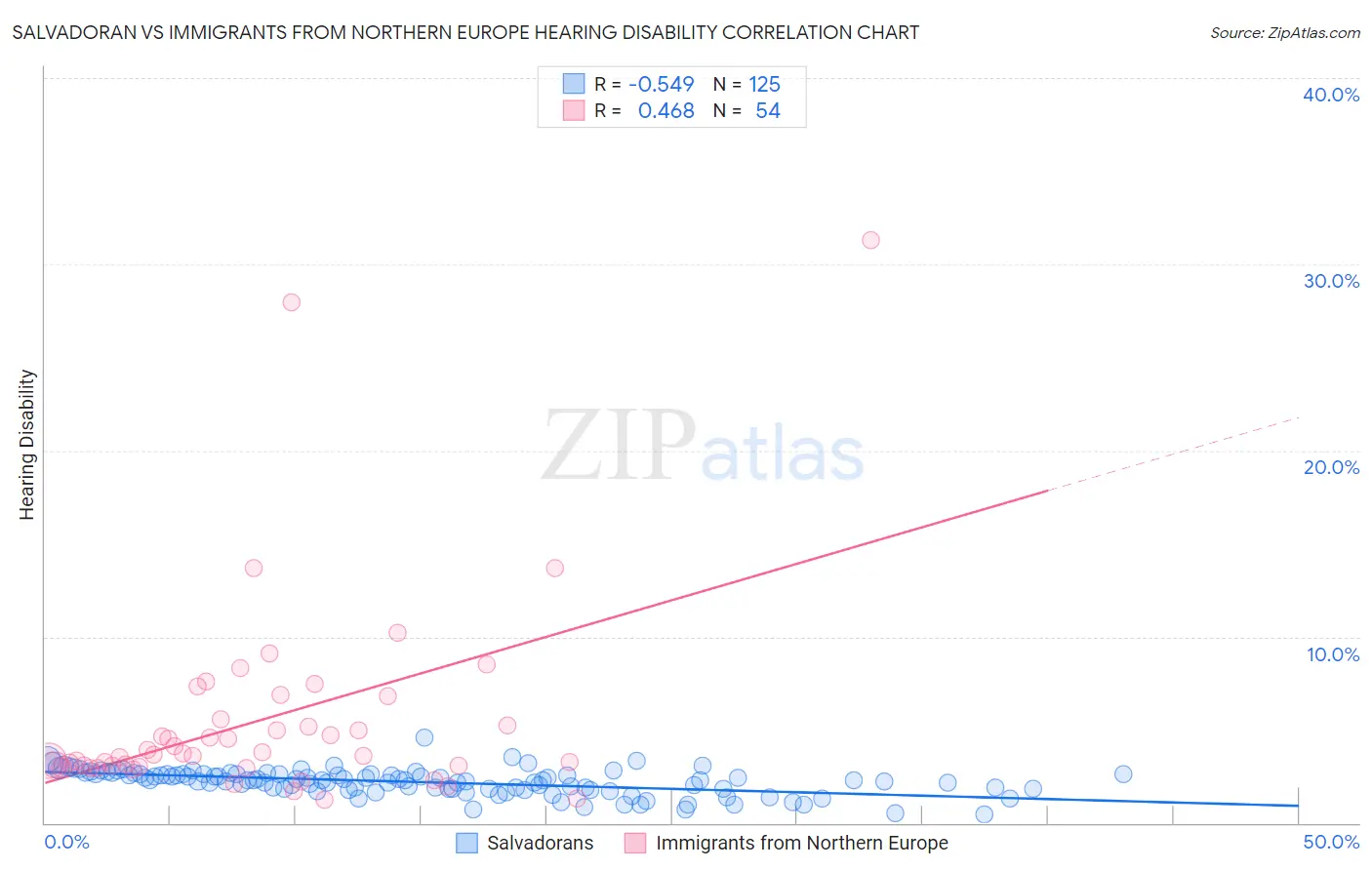Salvadoran vs Immigrants from Northern Europe Hearing Disability
COMPARE
Salvadoran
Immigrants from Northern Europe
Hearing Disability
Hearing Disability Comparison
Salvadorans
Immigrants from Northern Europe
2.6%
HEARING DISABILITY
99.6/ 100
METRIC RATING
35th/ 347
METRIC RANK
3.2%
HEARING DISABILITY
7.0/ 100
METRIC RATING
218th/ 347
METRIC RANK
Salvadoran vs Immigrants from Northern Europe Hearing Disability Correlation Chart
The statistical analysis conducted on geographies consisting of 398,804,647 people shows a substantial negative correlation between the proportion of Salvadorans and percentage of population with hearing disability in the United States with a correlation coefficient (R) of -0.549 and weighted average of 2.6%. Similarly, the statistical analysis conducted on geographies consisting of 477,037,225 people shows a moderate positive correlation between the proportion of Immigrants from Northern Europe and percentage of population with hearing disability in the United States with a correlation coefficient (R) of 0.468 and weighted average of 3.2%, a difference of 21.8%.

Hearing Disability Correlation Summary
| Measurement | Salvadoran | Immigrants from Northern Europe |
| Minimum | 0.44% | 1.2% |
| Maximum | 4.6% | 31.3% |
| Range | 4.1% | 30.1% |
| Mean | 2.2% | 5.6% |
| Median | 2.3% | 3.7% |
| Interquartile 25% (IQ1) | 1.8% | 3.1% |
| Interquartile 75% (IQ3) | 2.6% | 5.5% |
| Interquartile Range (IQR) | 0.81% | 2.5% |
| Standard Deviation (Sample) | 0.67% | 5.5% |
| Standard Deviation (Population) | 0.67% | 5.4% |
Similar Demographics by Hearing Disability
Demographics Similar to Salvadorans by Hearing Disability
In terms of hearing disability, the demographic groups most similar to Salvadorans are Immigrants from Pakistan (2.6%, a difference of 0.12%), Filipino (2.6%, a difference of 0.16%), Okinawan (2.6%, a difference of 0.22%), Immigrants from Western Africa (2.6%, a difference of 0.25%), and Immigrants from Jamaica (2.6%, a difference of 0.33%).
| Demographics | Rating | Rank | Hearing Disability |
| Immigrants | Haiti | 99.7 /100 | #28 | Exceptional 2.6% |
| Bolivians | 99.7 /100 | #29 | Exceptional 2.6% |
| Immigrants | Caribbean | 99.7 /100 | #30 | Exceptional 2.6% |
| Immigrants | Cameroon | 99.7 /100 | #31 | Exceptional 2.6% |
| Immigrants | Venezuela | 99.7 /100 | #32 | Exceptional 2.6% |
| Filipinos | 99.6 /100 | #33 | Exceptional 2.6% |
| Immigrants | Pakistan | 99.6 /100 | #34 | Exceptional 2.6% |
| Salvadorans | 99.6 /100 | #35 | Exceptional 2.6% |
| Okinawans | 99.6 /100 | #36 | Exceptional 2.6% |
| Immigrants | Western Africa | 99.6 /100 | #37 | Exceptional 2.6% |
| Immigrants | Jamaica | 99.5 /100 | #38 | Exceptional 2.6% |
| Immigrants | China | 99.5 /100 | #39 | Exceptional 2.6% |
| Haitians | 99.5 /100 | #40 | Exceptional 2.6% |
| Immigrants | Taiwan | 99.4 /100 | #41 | Exceptional 2.6% |
| West Indians | 99.4 /100 | #42 | Exceptional 2.6% |
Demographics Similar to Immigrants from Northern Europe by Hearing Disability
In terms of hearing disability, the demographic groups most similar to Immigrants from Northern Europe are Russian (3.2%, a difference of 0.040%), New Zealander (3.2%, a difference of 0.060%), Immigrants from Norway (3.2%, a difference of 0.12%), Malaysian (3.2%, a difference of 0.12%), and Immigrants from Laos (3.2%, a difference of 0.12%).
| Demographics | Rating | Rank | Hearing Disability |
| Romanians | 12.1 /100 | #211 | Poor 3.1% |
| Pakistanis | 11.1 /100 | #212 | Poor 3.1% |
| Immigrants | Iraq | 10.5 /100 | #213 | Poor 3.1% |
| Australians | 8.1 /100 | #214 | Tragic 3.2% |
| Bangladeshis | 8.1 /100 | #215 | Tragic 3.2% |
| Immigrants | Norway | 7.3 /100 | #216 | Tragic 3.2% |
| Russians | 7.1 /100 | #217 | Tragic 3.2% |
| Immigrants | Northern Europe | 7.0 /100 | #218 | Tragic 3.2% |
| New Zealanders | 6.8 /100 | #219 | Tragic 3.2% |
| Malaysians | 6.6 /100 | #220 | Tragic 3.2% |
| Immigrants | Laos | 6.6 /100 | #221 | Tragic 3.2% |
| Immigrants | Oceania | 6.5 /100 | #222 | Tragic 3.2% |
| Mexicans | 5.6 /100 | #223 | Tragic 3.2% |
| Icelanders | 5.2 /100 | #224 | Tragic 3.2% |
| Latvians | 5.1 /100 | #225 | Tragic 3.2% |